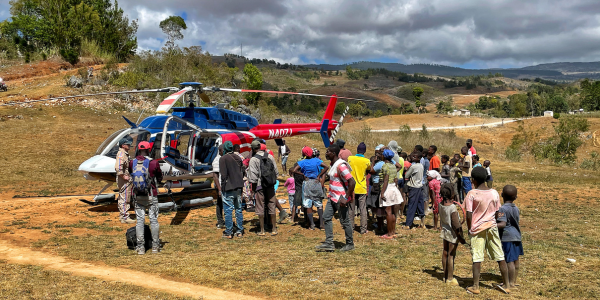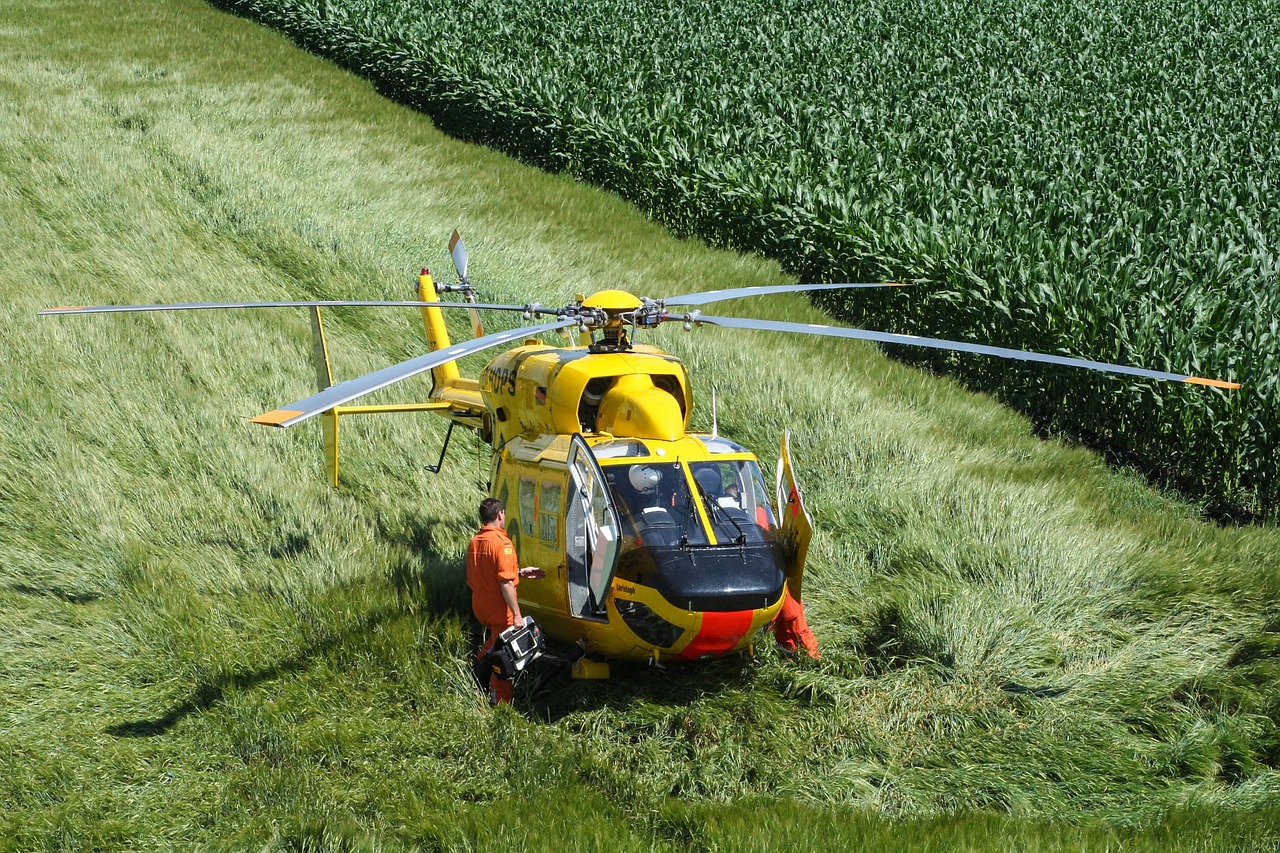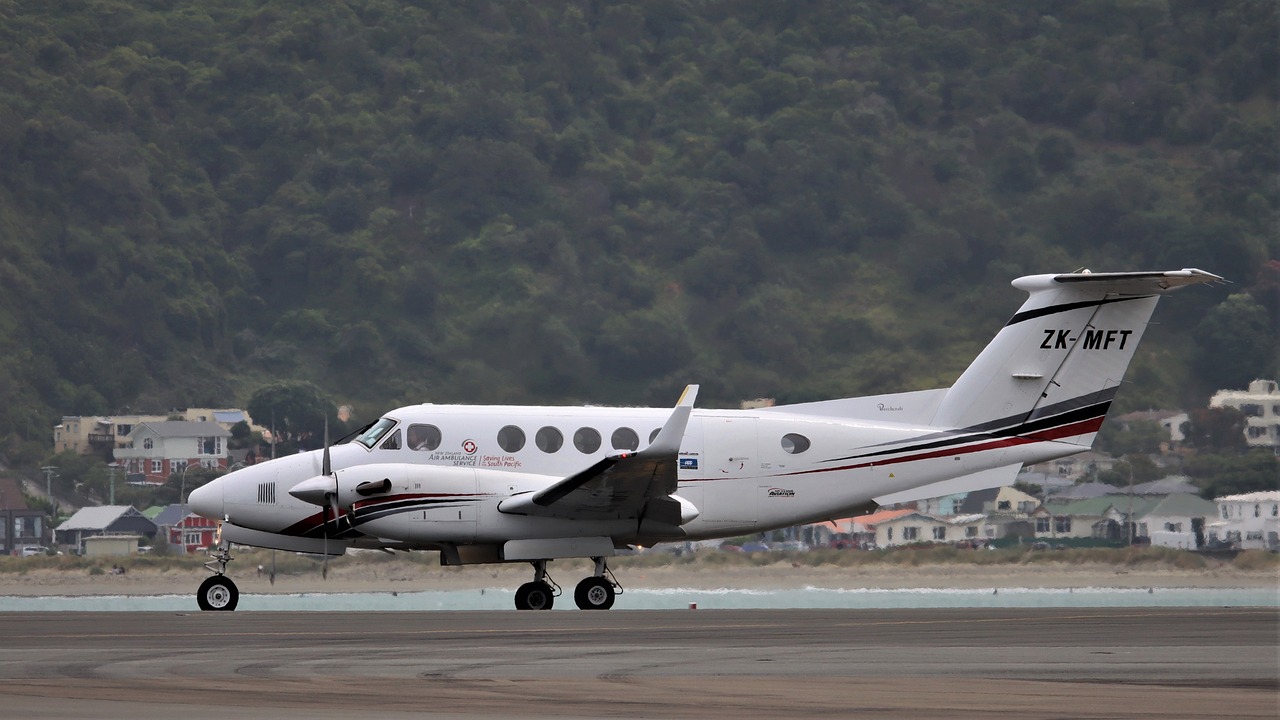So, picture this: You’re in a remote rural area, miles away from the nearest hospital. Suddenly, a medical emergency strikes. You’re left feeling helpless, wondering how long it will take for help to arrive. Well, my friend, that’s where air ambulances come in. These flying medical marvels are designed to bridge the gap in rural healthcare, bringing critical medical care to those in need, no matter how remote their location may be. In this article, we’ll explore the vital role air ambulances play in rural healthcare and how they are capable of saving lives in even the most challenging situations. So, buckle up and get ready for a high-flying adventure into the world of air ambulances!

The Importance of Air Ambulances in Rural Healthcare
When it comes to accessibility to healthcare services in rural areas, there can often be significant challenges. Limited infrastructure, long distances, and adverse weather conditions can all make it difficult for people in rural communities to access the medical care they need in a timely manner. This is where air ambulances play a crucial role in bridging the gap and ensuring that individuals in rural areas have access to the healthcare they require.
Accessibility to healthcare services in rural areas
Rural healthcare faces unique challenges due to its remote location and limited resources. Many rural areas are characterized by long distances to the nearest hospital or healthcare facility, making it difficult for individuals to seek medical attention in cases of emergencies or for routine check-ups. Additionally, limited infrastructure such as roads and transportation options can further impede access to healthcare services.
Challenges faced in rural healthcare
One of the biggest challenges in rural healthcare is the limited availability of healthcare facilities and specialists. Rural areas often struggle to attract and retain doctors, nurses, and other medical professionals. This scarcity of healthcare providers can result in longer wait times for appointments and limited access to specialized care. Moreover, limited funding and resources can hinder the development and improvement of healthcare infrastructure in rural areas.
Role of air ambulances in bridging the gap
Air ambulances play a critical role in bridging the gap between rural areas and healthcare facilities. These specially equipped aircraft provide rapid transportation of patients, particularly in emergencies where time is of the essence. By reducing travel time, air ambulances help improve patient outcomes by ensuring that individuals receive timely medical treatment.
Advantages of Air Ambulances in Rural Healthcare
The use of air ambulances in rural healthcare brings forth several advantages that can significantly impact patient care and outcomes.
Reduced travel time and improved patient outcomes
One of the most significant advantages of air ambulances is the reduced travel time they offer. By bypassing road congestion and traffic, air ambulances can transport patients to healthcare facilities in a fraction of the time it would take using conventional ground transportation. This reduction in travel time can be life-saving, especially for patients who require immediate medical attention or are in critical condition. Studies have shown that shorter transport times correlate to improved patient outcomes, including increased chances of survival and decreased morbidity rates.
Ability to reach remote and inaccessible areas
In rural areas with limited infrastructure and geographical challenges, air ambulances provide a lifeline for those in need of medical care. These aircraft have the ability to reach remote and inaccessible areas that may be otherwise difficult to reach by road. In emergencies, where every second counts, air ambulances ensure that patients can be swiftly transported to the nearest healthcare facility, regardless of the remoteness or terrain.
Emergency response and critical care capabilities
Air ambulances are equipped with specialized medical equipment and staffed by highly trained medical professionals. This enables them to provide emergency medical services and critical care during the transportation of patients. In cases where patients require immediate medical interventions or monitoring, air ambulances are equipped to deliver on-board life support and advanced medical care. This level of care during transit can be critical for patients in critical condition, allowing them to receive necessary treatments and interventions en route to the hospital.
Factors Affecting Air Ambulance Operations in Rural Areas
While air ambulances offer significant advantages in rural healthcare, there are several factors that can impact their operations in these areas.
Limited infrastructure and landing sites
Rural areas often lack the infrastructure required for air ambulance operations. The absence of suitable landing sites, such as helipads or runways, can limit the accessibility of air ambulances to certain areas. This necessitates careful planning and coordination with local authorities to identify appropriate landing sites and ensure safe operations. In some cases, makeshift landing zones may need to be established for air ambulances to reach patients in remote or isolated locations.
Weather conditions and geographical challenges
Rural areas are often prone to adverse weather conditions and geographical challenges, such as mountainous terrains or dense forests. These factors can restrict the ability of air ambulances to fly safely and reach certain areas. Moreover, limited navigation aids can make it challenging for pilots to navigate accurately in these conditions. It is crucial for air ambulance providers to closely monitor weather conditions and have contingency plans in place to mitigate the impact of unfavorable weather on their operations.
High costs and funding issues
Operating air ambulances in rural areas can be cost-intensive. The expenses associated with aircraft maintenance, fuel, and staffing can be significantly higher compared to ground transportation. Additionally, rural areas often have limited funding and resources, which can make it challenging for healthcare providers to allocate sufficient funds for air ambulance services. Finding sustainable funding solutions and ensuring cost-effectiveness are important considerations for air ambulance providers in rural healthcare.
Types of Air Ambulances Used in Rural Healthcare
Air ambulances used in rural healthcare come in various types, each suited for specific scenarios and medical needs.
Helicopters
Helicopters are commonly used in air ambulance operations, particularly in areas where there are limited landing sites or in rugged terrains. Their ability to hover and land in small spaces makes them well-suited for emergency situations where time is critical, such as accidents or natural disasters. Helicopters are equipped with medical equipment and staffed with medical professionals to provide immediate care during transportation.
Fixed-wing airplanes
Fixed-wing airplanes, such as turboprops or jets, are often utilized for long-distance transportation of patients. These aircraft have the advantage of higher cruising speeds, allowing for quicker transportation to tertiary care centers or specialized healthcare facilities. Fixed-wing air ambulances are typically equipped with the necessary medical equipment and staffed with medical professionals to provide critical care during transit.
Rotary-wing aircraft
Rotary-wing aircraft, including helicopters and gyroplanes, are versatile air ambulances employed in rural healthcare. They are capable of vertical take-off and landing, making them suitable for areas with limited landing sites or uneven terrains. Rotary-wing aircraft are essential in providing emergency medical services and extracting patients from remote or inaccessible locations.
Multi-mission aircraft
Multi-mission aircraft, such as converted cargo planes or military aircraft, are designed to accommodate multiple patients and medical teams. These aircraft are equipped with a range of medical equipment and can be quickly transformed into mobile medical units. Multi-mission aircraft are particularly useful during disaster response or mass casualty incidents where a large number of patients need to be transported or provided with medical care.
Considerations for Air Ambulance Providers in Rural Areas
Air ambulance providers operating in rural areas must take various considerations into account to ensure efficient and effective transportation of patients.
Training and certification requirements
Medical and aviation personnel involved in air ambulance operations must undergo specialized training and certification in order to provide high-quality care and ensure the safety of the patients. This includes training in aeromedical procedures, flight safety, and emergency medical care. Additionally, air ambulance providers must comply with regulatory requirements for certifications and licenses to operate in rural areas.
Collaboration with local hospitals and healthcare providers
Air ambulance providers must establish strong collaborations with local hospitals and healthcare providers in rural areas. This includes coordinating patient transfers, developing protocols for seamless care transitions, and sharing information for patient history and medical records. Collaborations help ensure that patients receive appropriate and continuous care throughout the transportation process, from the time they are picked up by the air ambulance to when they arrive at the receiving healthcare facility.
Adapting to specific healthcare needs
Each rural area has unique healthcare needs and challenges. Air ambulance providers must be able to adapt their services to meet these specific needs. This may include providing specialized equipment or medical personnel to handle specific medical conditions prevalent in the area. Understanding and addressing these unique healthcare requirements are crucial for air ambulance providers to deliver effective and appropriate care to rural communities.
Patient transfer protocols
Establishing clear patient transfer protocols is essential for air ambulance providers operating in rural areas. These protocols should include guidelines for triaging patients, determining the appropriate mode of transportation (helicopter, fixed-wing airplane, etc.), and coordinating with receiving healthcare facilities. Effective communication and coordination between air ambulance providers and healthcare providers are vital to ensure a smooth and efficient transfer of patients.
The Role of Technology in Enhancing Air Ambulance Services in Rural Areas
Technological advancements play a significant role in enhancing air ambulance services in rural areas. Here are some ways technology is being utilized to improve patient care and transportation.
Telemedicine and remote patient monitoring
Telemedicine enables healthcare professionals to remotely evaluate and treat patients using telecommunications technology. During air ambulance transportation, telemedicine can be utilized to connect medical personnel onboard the aircraft with doctors or specialists at the receiving healthcare facility. This allows for real-time communication, consultation, and guidance, improving the quality of care provided to patients during transit. Additionally, remote patient monitoring systems can transmit vital signs and patient data to the receiving healthcare facility, enabling healthcare professionals to monitor patients’ conditions remotely.
Advanced navigation and communication systems
Air ambulances rely on advanced navigation systems that provide accurate and real-time information on aircraft position, weather conditions, and obstacles. These systems aid pilots in navigating complex terrains and adverse weather conditions, ensuring safe and efficient transportation. Additionally, robust communication systems allow for seamless communication between the air ambulance crew, healthcare providers, and receiving facilities, facilitating coordination and information exchange.
Improved safety and medical equipment
Advancements in medical technology have resulted in the development of specialized equipment for air ambulances. These include portable diagnostic tools, advanced life support systems, and monitoring devices specifically designed for use during air transportation. Improved safety features, such as enhanced crashworthiness and advanced restraint systems, also contribute to ensuring the safety of both patients and crew during air ambulance operations in rural areas.
Regulations and Standards in Air Ambulance Operations
Air ambulance operations are subject to various regulations and standards to ensure patient safety and quality of care.
Federal Aviation Administration (FAA) regulations
The FAA establishes regulations and guidelines that govern the operation of air ambulances. These regulations cover aircraft certification, pilot qualifications, maintenance standards, and operational requirements. Compliance with FAA regulations is essential to ensure the safety of patients, crew, and aircraft during air ambulance operations in rural areas.
Air Medical Transport Accreditation (AMTA) standards
The AMTA sets industry standards and accreditation criteria for air ambulance providers. These standards cover various aspects, including medical crew qualifications, equipment, safety policies, patient care protocols, and quality assurance. By adhering to AMTA standards, air ambulance providers demonstrate their commitment to delivering high-quality care and ensuring the safety of both patients and crew.
Minimum equipment and staffing requirements
Air ambulance operations in rural areas must meet minimum equipment and staffing requirements to provide safe and effective patient care. This includes having the necessary medical equipment and supplies onboard the aircraft, as well as ensuring an adequate number of trained medical professionals to handle patient care during transportation. Compliance with these requirements helps ensure that air ambulance providers are capable of delivering the appropriate level of care to patients in rural communities.
Case Studies: Successful Implementation of Air Ambulances in Rural Areas
Several case studies demonstrate the successful implementation of air ambulances in providing healthcare services to rural communities.
Case study 1: Improving access to emergency obstetric care in remote areas
In a rural area with limited access to emergency obstetric care, the introduction of air ambulances significantly improved maternal and neonatal outcomes. Air ambulances were utilized to swiftly transport pregnant women experiencing complications to tertiary care centers equipped with specialized obstetric services. This timely intervention reduced maternal and neonatal mortality rates and ensured that women in remote areas had access to adequate healthcare during childbirth.
Case study 2: Transporting critically ill patients from rural hospitals to tertiary care centers
Air ambulances played a crucial role in transporting critically ill patients from rural hospitals to tertiary care centers for specialized treatment. By providing rapid transportation and critical care capabilities en route, air ambulances ensured that patients received timely and appropriate care. This reduced the need for long-distance ground transportation that may not have provided the necessary level of care for patients in critical condition.
Case study 3: Providing specialized medical care to remote indigenous communities
For remote indigenous communities with limited healthcare infrastructure, air ambulances have been instrumental in providing specialized medical care. By partnering with local healthcare providers and working closely with community leaders, air ambulance providers have delivered specialized medical teams and equipment to these communities. This has resulted in improved access to healthcare services and increased the ability to provide culturally appropriate care to indigenous populations.
Challenges and Future Considerations for Air Ambulances in Rural Healthcare
While air ambulances have proven to be invaluable in bridging the healthcare gap in rural areas, several challenges and future considerations must be addressed to ensure their sustainability and effectiveness.
Sustainability and cost-effectiveness
Operating air ambulances in rural areas can be financially challenging due to the high costs associated with maintenance, staffing, and fuel. Finding sustainable funding solutions and exploring cost-effective models of operation are essential for air ambulance providers in rural healthcare. This may involve collaborations with healthcare facilities, local governments, and community organizations to secure funding and optimize resource allocation.
Integration with existing healthcare systems
To maximize the impact of air ambulances in rural healthcare, integration with existing healthcare systems is crucial. Seamless coordination between air ambulance providers, healthcare facilities, and local healthcare networks must be established to ensure efficient patient transfers and continuity of care. This integration requires effective communication, information sharing, and standard protocols for patient handover and follow-up care.
Expanding coverage and availability
Expanding the coverage and availability of air ambulance services in rural areas remains a priority. Identifying underserved regions and addressing the gaps in access to healthcare services are critical for ensuring that air ambulance services reach those who need them the most. Innovation and collaboration are key to extending the reach of air ambulance services and making them readily available to all individuals in rural communities.
Conclusion
In conclusion, air ambulances play a vital role in bridging the gap in rural healthcare. They provide essential medical transportation services, improving patient outcomes by reducing travel time, reaching remote areas, and providing emergency response and critical care capabilities. While challenges exist, such as limited infrastructure, adverse weather, and high costs, technology advancements, strong collaborations, and adherence to regulations and standards enhance the efficiency and safety of air ambulance operations. With further consideration of sustainability, integration with existing healthcare systems, and expanded coverage, air ambulance services can continue to be a lifeline for individuals in need of healthcare in rural areas.



